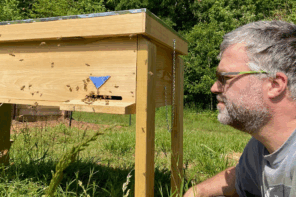Click Here if you listened. We’d love to know what you think. There is even a spot for feedback!
Read along below!
Building Frames
By: Stephen Bishop
Only beekeepers with the most trained and disciplined minds should tackle the tedious task of building frames. Unfortunately, frame assembly has broken many of the most promising beekeepers and left them in a state of disillusioned stupor. “Is that what I signed up for when I decided to become a beekeeper,” the fledgling beekeeper asks, “fiddling with endless amounts of sticks and tiny nails, all while this wood glue has dried and formed a new exodermal layer on my fingers?”
What is perhaps most disheartening for beginning beekeepers is the failed quest for the illusive rectangular shape — it happens to the best of us. I, for one, fondly remember my first frames, which had, at best, a triangular shape — they were horrible bee frames but acted as fine boomerangs when I flung them away from me in disgust. Eventually, I was able to progress to something that resembled a four-sided geometric shape, either a trapezoid or a parallelogram —which it was I cannot say because I was an English major. I do, however, remember my first true rectangle. It was a work of beauty, but unfortunately, I put the bottom bar on upside down, so that bee frame existed merely for aesthetic purposes.
Speaking of aesthetics, to many men, there is nothing finer than a pure and true rectangular form, with nary a curve or an acute angle anywhere to be seen. I suspect that is why, for so many years, super models looked like sticks. It is also likely why many women consider Brad Pitt to be the ideal masculine form — his face looks like a perfectly rectangle medium wood frame. Of course, this is getting into the realm of cultural taste and conjecture, and in these pages we’d be best to limit our inquiries to the hard sciences of applied apicultural research.
So why is nailing that tiny strip of wood so hard — you know, the strip of wood that holds the wax foundation in place? Has anyone ever conducted formal research on this major beekeeping problem? I suspect whoever designed that thin wood strip that must be tacked over the crimped wire ends with a tiny nail held at an impossible angle was either a three-handed lifeform or lacked formal training in engineering. Turns out Lorenzo Langstroth was a theology major, which explains a lot. He had the patience of God and was likely not tempted to use bad words when fumbling with tiny nails and hammering his thumb.
Many beekeepers have devised methods and bought tools to reduce the tedium of frame building, from jigs to nail guns to malt liquor. But nothing reduces the tedium quite so much as buying plastic frames, which is what truly advanced beekeepers do. Although the truth is that bees prefer wax foundation to plastic, after building wood frames for three hours, you’ll likely realize that we live in a post-truth era and that plastic works well enough.
That said, I would advise you to order the heavily waxed plastic foundation because bees draw it out better than standard plastic foundation. You could apply extra wax yourself but that takes you firmly into the territory of the second most tedious task in beekeeping, which is cleaning and rendering wax. Be advised: you should only attempt wax rendering outside of the earshot of small children because your wife will likely erupt with words that will stunt their growth as morally upright individuals when she discovers the condition of her cookware — unless, that is, she is a theology major.










